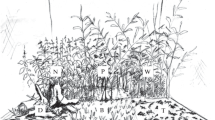Summary
I examined the foraging behavior during the breeding and non-breeding seasons, May and July 1986, of the fringe-toed lizard Uma inornata (Iguanidae). During the breeding season males differ from females in their diet and in their foraging time strategy, males exhibiting time minimization and females energy maximization. In May, plant associated foods were selectively eaten. Males concentrated on flowers, a readily available quick energy food, which reduced foraging time and increased time for reproductive activities. Time budgets indicate that males spend over twice as much time in the open and in movement in May than do females. Females at this time restrict their activities to the cover of perennial bushes, and feed primarily on plant foods (flowers and arthropods). Energy maximization appears to be maintained by both sexes in the non-breeding season when food resources diminished to one-half of those in the breeding season. The lizards were less selective in their July feeding habits, broadening their diets to include ground-dwelling arthropods and foliage. Predation by these lizards follows a wait-ambush mode of foraging.
Similar content being viewed by others
References
Altmann J (1974) Observational study of behavior: sampling methods. Behavior 49:227–265
Ballinger RE, Ballinger RA (1979) Food resources during periods of low and high food availability in Sceloporus jarrovi (Sauria: Iguanidae). Southwest Nat 24:347–363
Burquez A, Flores-Villela O, Hernandez A (1986) Herbivory in a small iguanid lizard, Sceloporus torquatus torquatus. J Herpetol 20:262–264
Caravello HE, Cameron GN (1987) Foraging time allocation in relation to sex by the gulf coast fiddler crab (Uca panacea). Oecologia 72:123–126
Durtsche RD (1987) Foraging and food of the fringe-toed lizard Uma inornata, an endangered species from the Coachella Valley, California. Masters thesis. California State Univ, Fullerton
Durtsche RD (1992) Foraging ecology of the fringe-toed lizard Uma inornata during periods of high and low food resources. In press: Copeia
Floyd HB, Jenssen TA (1983) Food habits of the Jamaican lizards Anolis opalinus: resource partitioning and seasonal effects examined. Copeia 1983:319–331
Golley FB (1961) Energy values of ecological materials. Ecology 42:581–584
Heifetz W (1941) A review of the lizards of the genus Uma. Copeia 1941:99–111
Hixon MA (1982) Energy maximizers and time minimizers: theory and reality. Am Nat 119:596–599
Hoffman SG (1983) Sex-related foraging behavior in sequentially hermaphroditic hogfishes (Bodianus spp.). Ecology 64:798–808
Jaeger EC (1969) Desert wild flowers. Stanford Univ Press, Stanford
Legler JM, Sullivan LJ (1979) The application of stomach-flushing to lizards and anurans. Herpetologica 35:107–110
Mautz WJ, Nagy KA (1987) Ontogenetic changes in diet, field metabolic rate, and water flux in the herbivorous lizard Dipsosaurus dorsalis. Physiol Zool 60:640–658
Mayhew WW (1964) Photoperiodic responses in three species of the lizard genus Uma. Herpetologica 20:95–113
Mayhew WW (1965) Reproduction in the sand-dwelling lizard Uma inornata. Herpetologica 21:39–55
Munz PA (1974) A flora of southern California. Univ California Press, Berkeley
Norris KS (1958) The evolution and systematics of the iguanid genus Uma and its relation to the evolution of other North American desert reptiles. Bull Am Mus Nat Hist 114:251–326
Norris KS, Lowe CH (1964) Analysis of background color-matching in amphibians and reptiles. Ecology 45:565–580
Paulissen MA (1987) Optimal foraging and intraspecific diet differences in the lizard Cnemidophorus sexlineatus. Oecologia 71:439–446
Pietruszka RD (1981) An evaluation of stomach flushing for desert lizard diet analysis. Southwest Nat 26:101–105
Roberts FM Jr (1986) Nomenclatural changes in a flora of southern California, PA Munz, 1974. Crossosoma 12:1–28
Robinson MD (1987) Diet diversity and prey utilisation by the omnivorous Namib Desert dune lizard, Aporosaura anchietae (Bocage), during two years of very different rainfall. J Arid Environ 13:279–286
Schoener TW (1969) Optimal size and specialization in constant and fluctuating environments: an energy-time approach. Brook Symp Biol 22:103–114
Schoener TW (1971) Theory of feeding strategies. Annu Rev Ecol Syst 2:369–404
Southwood TRE (1978) Ecological methods with particular reference to the study of insect populations. Chapman & Hall, London
Stebbins RC (1944) Some aspects of the ecology of the iguanid genus Uma. Ecol Monogr 14:311–332
Stebbins RC (1948) Nasal structure in lizards with reference to olfaction and conditioning of inspired air. Am J Anat 83:183–222
Stebbins RC (1954) Amphibians and reptiles of western North America. McGraw-Hill Book Co, Inc
Strauss RE (1979) Reliability estimates for Ivlev's electivity index, the foraging ratio, and a proposed linear index of food selection. Trans Am Fish Soc 108:344–352
Author information
Authors and Affiliations
Rights and permissions
About this article
Cite this article
Durtsche, R.D. Feeding time strategies of the fringe-toed lizard, Uma inornata, during breeding and non-breeding seasons. Oecologia 89, 85–89 (1992). https://doi.org/10.1007/BF00319019
Received:
Accepted:
Issue Date:
DOI: https://doi.org/10.1007/BF00319019




